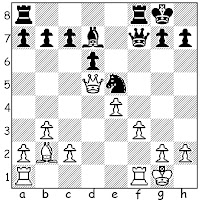Here's a Jerome Gambit game that's just fun to play through, as the "Jerome pawns" take on enemy pieces.
Digueno - nukslim
FICS, 2012
1.e4 e5 2.Nf3 Nc6 3.Bc4 Bc5 4.Bxf7+
4...Kxf7 5.Nxe5+ Nxe5 6.d4
6...Nf6 7.O-O Bd6 8.f4 Neg4 9.e5 Bb4 10.c3
10...Ba5 11.Qb3+ Kf8 12.h3 Nh6 13.Qa3+ d6 14.Qxa5 Nd7 15.f5 b6 16.Qd5 dxe5
Possibly hypnotized by the pawns... and then, without waiting Black resigned
graphic by Jeff Bucchino, The Wizard of Draws
I handed the following Jerome Gambit game by Bill Wall over to Houdini 2, to look at in "blunder check" mode, and was surprised that it had little to say, until the end, when it indicated that Black had blundered in a largely even position.
That indicates one of the fascinations of the Jerome: Black doesn't have to blunder to lose, he only needs to put together a series of second- or third-best moves, while White develops and begins making threats - and the opening is again "justified".
The Jerome Gambit may not be anything to try against a computer, but it continues to provide interesting play against people.
Wall, Bill - Guest1475978
Playchess.com, 2013
1.e4 e5 2.Nf3 Nc6 3.Bc4 Bc5 4.Bxf7+
4...Kxf7 5.Nxe5+ Nxe5 6.Qh5+ Ng6 7.Qd5+ Ke8 8.Qxc5 d6 9.Qh5
After delivering a typical "nudge" (7.Qd5+) White's Queen decides that she wants to take a different way home. There are only 10 previous examples in The Database's 27,400 games, and White had (up until this point) only scored 45%, but Bill was exploring and taking his opponent out of any "book" he might have been familiar with.
9...Nf6 10.Qe2 Kf7 11.O-O Re8 12.d3 Kg8
Black has wisely castled-by-hand, one indication that he might know something about the Jerome.
13.f4 a6 14.f5 Ne7 15.g4 Qd7 16. g5 Nxe4 17.dxe4 Nxf5
Black continues in knowing fashion, returning his piece for two pawns, relying on his better pawn structure to reassure him of progress.
18.Nc3 Nd4 19.Qc4+ Ne6
This all seems so well-prepared, until you begin to ask: What does Black do next? Does he really have to move his King so that he can move his Knight so that he can move his Queen so that he can move his Bishop?
20.Be3 b5 21.Qd5 c6 22.Qf5
White continues to move his Queen in a disconcerting manner, as we have seen recently in "A Day in the Life of the Jerome Gambit" and "You can't play like that!"
22...Qe7 23.a3 Nc5 24.Qf3 Nxe4
Pleased with his maneuvering, Black triumphantly snaps off the weak e-pawn (see the note to move 17) and Houdini 2 murmers that White now has a small edge.
25.Nxe4 Qxe4
If only chess were this simple. Houdini 2 recommends instead: 25...d5 26.Nf6+ gxf6 27.Rae1 Qg7 28.Kh1 f5 29.g6 hxg6 30.Bd4 Rxe1 31.Bxg7 Rxf1+ 32.Qxf1 Kxg7 when Black has a Rook, a Bishop, and two pawns for his Queen.
26.Qf7+ Kh8 27.Qf8+ Rxf8 28.Rxf8 checkmate
(And that is why Bill Wall scores 96% with the Jerome Gambit, according to The Database - although I may have missed a win or two.)
As you may have noticed in recent posts, I have added Houdini 2 to my cast of analysis partners (including Rybka 3 and Fritz 10) for games reviewed on this site. It races through the plys in its analysis, while remaining quite strong. While I still refer to Rybka 3 for more positional questions, I have been finding a whole new perspective on the Jerome Gambit lines with Houdini 2.
One example: after a long think, its preference after 1.e4 e5 2.Nf3 Nc6 3.Bc4 Na5!? is neither the Jerome-ish 4.Bxf7+!? nor the straight-forward 4.Nxe5, but 4.Be2. Interesting...
The free version of Houdini 1.5 is available here.
Some Jerome Gambit games are instructive, from beginning to end, showing what a player must face and accomplish in order to be successful.
Wall,B - Guest903719
playchess.com, 2013
1.e4 e5 2.Nf3 Nc6 3.Bc4 Bc5 4.Bxf7+
4...Kxf7 5.Nxe5+ Nxe5 6.d4
6...Bxd4 7.Qxd4 d6 8.0-0 Nf6 9.f3
This is an interesting Theoretical Novelty. Previous play has centered around White working quickly for e5 or f5, while Black counters with pressure from his Rook along the e- or f-file.
9.f4 is a continuation going back to Jerome,A - Shinkman,W, Iowa, 1876 (½-½, 42).
9...Rf8 10.Nc3 Kg8 11.b3 Bd7 12.Bb2 Qe8 13.Nd5 Nxd5 14.Qxd5+ Qf7
White is planning another episode of "You can't play like that!"
15.Qxb7 Bc6 16.Qa6
Threatening 17.Bxe5.
16...Qd7 17.Rfd1
Threatening 18.Bxe5
17...Bb5 18.Qb7 Ng6
White has grabbed a second pawn to compensate for his sacrificed piece, he has a strong Bishop at b2, and there are weaknesses on the light squares in Black's position.
A computer would still like Black, but this is a human vs human contest.
19.e5 Nf4?!
Bill recommends, instead, 19...Bc6 20.Qb4 d5.
20.exd6 cxd6 21.Qxd7 Bxd7 22.Rxd6
All Jerome Gambit players should become familiar with playing this kind of position for White. With three pawns for a piece, White has gained material equality, but his "Jerome pawns" give him "means, motive and opportunity" to try for more.
22...Bf5 23.Re1 Bxc2 24.Re7 Rf7 25.Rxf7 Kxf7 26.Rd7+ Ke6 27.Rd2 Rc8 28.Bxg7 Bg6
29.g3 Nd3 30.Kg2 Rc1 31.g4 Re1 32.Bd4 a6 33.h4 Kd5 34.Bf2 Ra1?
Black misses the opportunity to exchange down to a drawn Bishops-of-opposite-colors endgame with 34...Re2 35.Rxe2 Nf4+ 36.Kf1 Bd3 37.Ke1 Bxe2 38.Be3 Bxf3 39.Bxf4 Bxg4.
This blog has presented many examples of the resources and pitfalls of such endings.
35.h5 Be4 36.fxe4+ Kxe4 37.Kg3 Nc1
This may have been what Black had in mind when he gave up his Bishop for a pawn (the White Queenside pawns fall), but White has seen further.
38.Rd4+ Ke5 39.Rd7 Rxa2 40.Rxh7 Nxb3 41.Re7+ Kf6
42.h6! Kxe7 43.h7 Kf6 44.h8Q+ Ke7 45.Qe5+ Kd7 46.Qd5+ Ke7 47.Qxb3 Black resigned

























